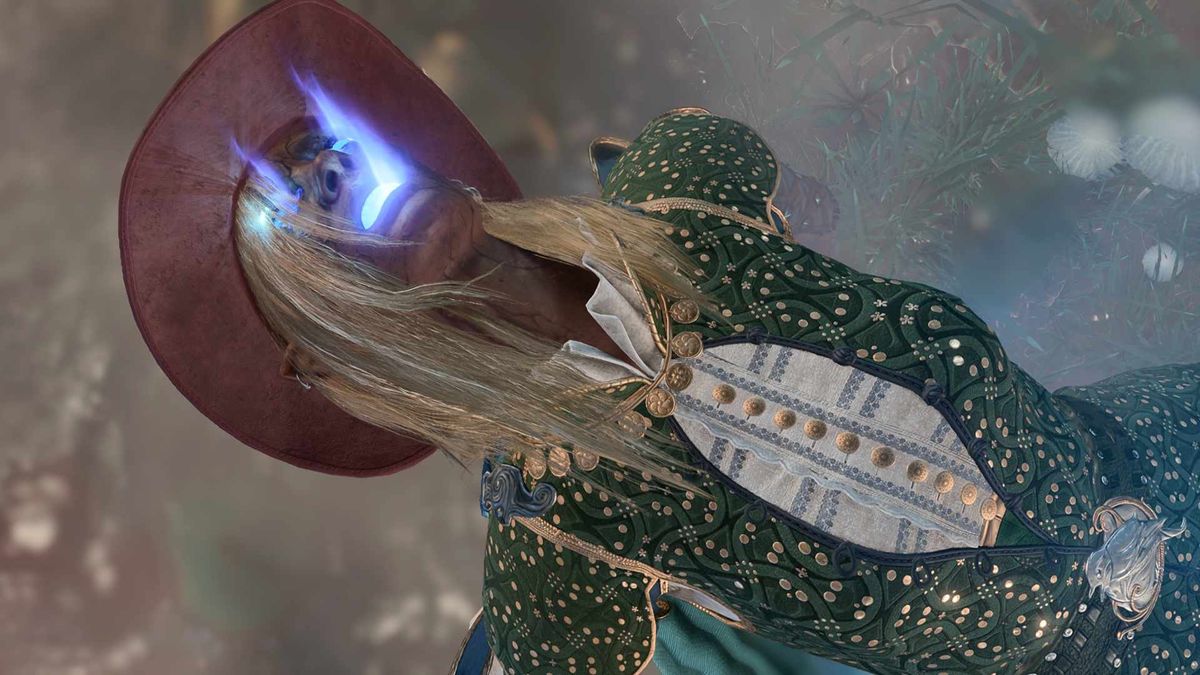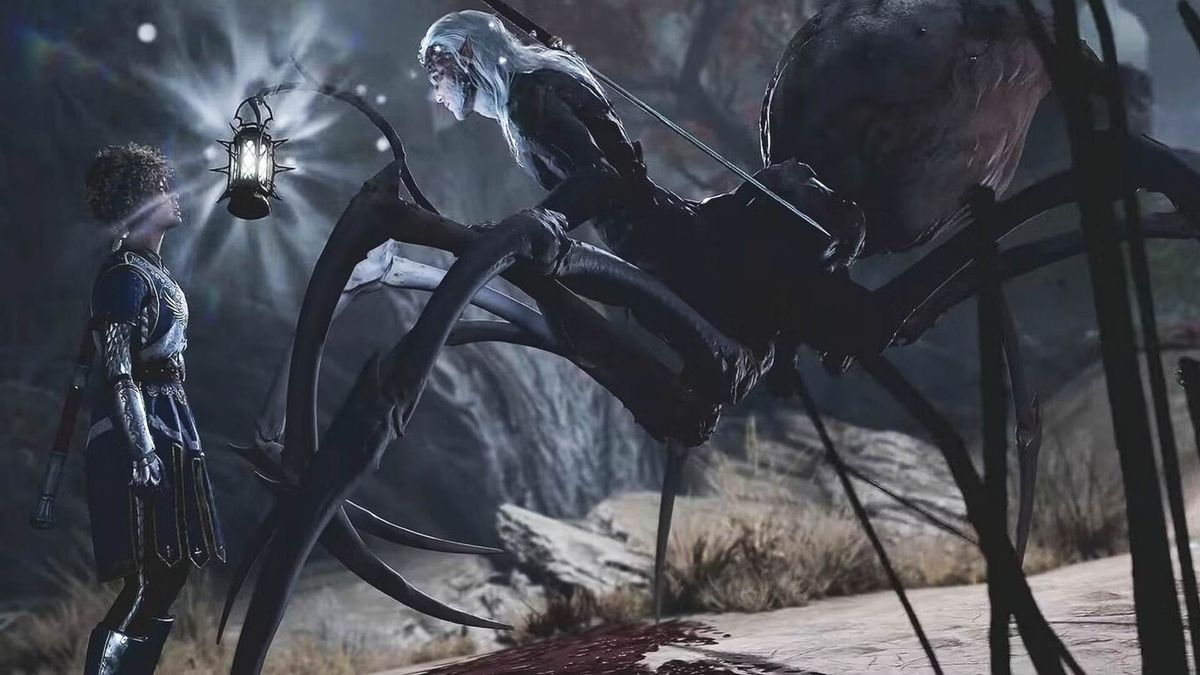The Elden Ring Maliketh the Black Blade boss fight has players go up against Gurranq, Beast Clergyman… only to discover that he’s been hiding another identity the whole time as the legendary keeper of Destined Death: Maliketh, a major figure in the mythology of Elden Ring. Coming in two phases and deadly whether he’s going as Maliketh or the Beast Clergyman, he’s a powerful enemy using fast, sweeping strikes and lingering damage effects to devastate his enemies. Players will have to have all their wits about them to survive this legendary battle, and we can help them surpass this hurdle with our guide on how to beat the Elden Ring Maliketh boss fight at the final arena of Crumbling Farum Azula.
How to beat Maliketh, the Black Blade in Elden Ring

The Maliketh Elden Ring boss fight comes at the player in two phases: in Phase 1, he appears as the cloaked Beast Clergyman, but in Phase 2 he sheds this disguise and unleashes the full power of Destined Death as Maliketh, the Black Blade. His attacks become more elaborate, reduce your max HP, and gain a deadly burning effect that damages the player for a while after being struck. We’ll cover both phases below, with specific counters for each, as well as what you can do to prepare for this boss fight before going in.
Maliketh Tips and Tricks to prepare for the boss fight

Maliketh is a comparative glass cannon, at least when framed against bosses you’ve fought recently. He doesn’t have a particularly large health bar, but he’s fast and deadly enough that it hardly matters, leaping across the battlefield and striking back players with lethal sword blows. Fortunately there’s a lot you can do to help deal with Marika’s Shadow, with items and strategies to help you prepare for a boss fight that marks a turning point.
Warning: After beating Maliketh, the area of Leyndell will suddenly change significantly, altering the landscape and making many items and enemies in the area unaccessible for the rest of the campaign (though this doesn’t extend to the Subterranean Shunning Grounds and Catacombs beneath Leyndell). Make sure you finish any business you have in the Royal Capital before killing Maliketh!
If you plan on taking on Maliketh regardless, here’s some advice we recommend you take before going into the arena itself to help you prepare both a good defence and offence.
- Maliketh has a recommended level of at least 115, with weapons at +20 or higher. If you haven’t reached this point, it may be worth going to explore and grind a little more before going into the battle.
- The Draconic Tree Sentinel sub-boss who guards the door outside is a pain to deal with, easy to evade but hitting hard if you get caught in his hammer blows and fire breath. Either sprint past him each time (he has to unsheathe his weapon whenever he sees you, buying you a few moments), or take some time to deal with him once and for all. He has all the same moves as the one outside Leyndell, but with extra health. If you do kill him, you’ll get the ugly-but-effective Malformed Dragon armor set, which is comparatively light for its robust defensive stats.
- The Draconic Knight can’t follow you through the gold fog door, but we have been hit by his attacks through it, the shockwave from the hammer making it into the arena. Put at least a little distance between you and the door if you’re letting him live.
- Maliketh is incredibly resistant to Holy damage, and pretty resistant to Bleed. If you’re going in to fight him, avoid using the former of these at all costs.
- His own attacks do standard physical damage in Phase 1, with additional Magic damage in Phase 2. Armor that blunts these effects certainly wouldn’t be a bad idea.
- A shield isn’t the worst thing in this fight (though dodging is always better), though it won’t protect you from the lingering burning effect his attacks have in the second phase.
- Maliketh can’t be parried unless you find a special tool item called the Blasphemous Claw, dropped by the invader NPC Recusant Bernahl at the rotunda to the North of the Great Bridge Site of Grace in Farum Azula. The Blasphemous Claw can be triggered to parry certain weapon attacks made in Maliketh’s second phase. Activate it when you see his sword suddenly glow yellow to stagger him. That being said, this is a difficult item to get used to, and it might be easier in the long run to just… dodge. After all, if you screw it up, you’re taking a god-blade to the nose.
- Maliketh’s speed and AOE attacks mean that Spirit Summons might literally struggle to keep up with him, as he can pounce on a foe, knock them down and backflip away in an instant. If you aspire for your summons to do more than simply distract the Black Blade, you’ll need to either summon groups of minions, ranged spellcasters, or fast-moving allies like Black Knife Tiche. Actually, at this point in the game, you should probably summon Black Knife Tiche for everything, but that’s not an option everybody has at their disposal.
- The pillars in the arena can be helpful for blocking certain projectiles, but they’re also a little unreliable. Don’t assume they’re the perfect defence, we’ve been caught out by that one.
- Any of the Great Runes are good here, but considering you’ll be losing a lot of health and max HP, Morgott’s or even Malenia’s Great Rune could be a boon (though admittedly the latter is more risky).
Now that you’re prepared, head inside and encounter a familiar face barrelling towards you…
Maliketh Phase 1: Beast Clergyman

All Deathroot locations

Looking for the Elden Ring Deathroot locations to feed to Gurranq in Caelid? We’ve got all those listed for you here!
The first half of the boss fight, the Phase 1 Beast Clergyman, is the easier of the two, but that doesn’t mean it’s a walk in the park regardless. Gurranq is a frustratingly chaotic opponent, leaping about, throwing rocks without warning, moving unpredictably and generally harrowing the player Tarnished to their grave.
If you’re using a Spirit Summon or other item, you have a small window here, as the Clergyman starts at the opposite end of the arena and will run towards you when he sees you enter. Here’s some basic advice for dealing with this cleric’s friend-turned-foe.
- Once you’re inside, get off the little bridge you appear on! It’s very easy for the Clergyman to knock you around and off into the bottomless pit that encircles the arena.
- The Beast Clergyman uses sweeping, rapid attacks and short-ranged damaging spells, sending rocks, projectiles and boulders at the player. Unlike most magic attacks these can be blocked with a shield, though their heavy power means you’ve a good chance of being staggered.
- The Clergyman has quite poor posture, and heavy attacks can stagger him if you can land enough of them, leading up to a riposte. In fact, posture carries over, so you could theoretically hit him with a few heavy attacks in Phase 1 to wear him down, then hit with one more in Phase 2 to hurt Maliketh.
- The Clergyman’s speed and constant motion means that if you’re a mage, your own slower spells might struggle to hit him. Both of you will have trouble fighting at range, though any summons might hold his attention long enough for you to hit him with a few shots.
- As a general rule, most of what the Clergyman does can be dodged by rolling forwards towards him, especially his cast magic.
- Try never to be without at least some stamina – the Clergyman’s speed and unpredictability means you’ll have to dodge an attack without warning at any point.
- When he creates the Beast Claw Incantation with blades emanating outwards, rather than dodge, simply try to stand between the blades rather than dodge or block them. It’s your best chance.
- The Clergyman’s most dangerous attack is one where he grabs the ground and raises boulders above him that crash down. You can see dust columns where they’re about to land – don’t get close to those!
Chip him down to half health, and he’ll have what’s either a moment of clarity, or go into a further frenzy, depending on your perspective. This is where things get complicated, and this pious pile of rags and hair turns into something a lot more dangerous.
Maliketh Phase 2: The Black Blade

Shedding his robes and revealing black armor, along with a rather ominous glowing sword, Maliketh the Black Blade has his own moveset distinct from the Clergyman’s, but thankfully it’s not too different and a lot of the lessons from before still apply. As mentioned, the big threat now is the lasting damage inflicted by the sword – and a horrible secondary effect we’ll explain below.
- Maliketh’s sword not only does major damage when it hits the player, but they’ll continue to take small amounts of damage for five seconds, even if they heal part way through.
- Even worse, being hit by the sword or any of his red projectile effects lowers your maximum HP by a small amount. This effect stacks, and it’s entirely possible to see your max health halved in a barrage of strikes, not to mention the lasting effect from the sword’s “fire” on top of that.
- If this happens, your max health comes back over the course of the fight, but it’s slow to do so. We timed it, and by our estimate it takes twenty seconds for it to even start coming back, and does so in such small increments that you’ll still need to be very careful.
- This is the point where you can start using the Blasphemous Claw to parry his yellow-glowing strikes, if you’re so inclined, but it’s a tricky enough procedure that we can’t recommend it as some obvious help like Margit’s Shackles. Sometimes just getting stuck in with a sword rather than looking for a temperamental exploit is better.
- Maliketh leaps around a lot, and when he’s in the air, you’ve probably got less than a second before he either lands on you or fires a projectile attack. Abandon any shield you were using for the Clergyman, he’s too powerful to be blocked in this manner by all but the most specialised shield.
- Maliketh has multiple powerful attacks that start with him burying his sword in the ground, usually followed by an AOE attack of some sort. The moment you see him do this, roll back fast!
- His standard melee attacks tend to be forward facing, so you’re a little safer being behind him. However, his speed and agility means he can reposition himself in an instant, so keep your guard up.
- Sometimes Maliketh starts leaping between the pillars, firing projectiles. There isn’t a lot you can do about this, especially if you’re a melee fighter. Use the other pillars to protect yourself where possible, and make sure you can see where he is at all times – it’s very easy to lose track of him and take a clump of necromancy to the back of the head. Eventually he’ll come back down to ground level and you can keep fighting.
We said it before, but Maliketh’s unmatched evasion is to compensate for his relatively low health. You don’t have to hit him much to take him down, so keep picking your shots carefully and playing as cautious as he plays aggressive. Eventually you’ll take him down and be done with the fight – congratulations! You’re now just a few boss fights off saving the world, or ending it altogether, depending on which of the Elden Ring endings you’re pursuing.
Maliketh rewards and the Remembrance of the Black Blade

Killing Maliketh earns you 220000 Runes, as well as the Remembrance of the Black Blade, which, as ever, can be brought back to Enia at the Roundtable Hold. It can be turned either into Maliketh’s Black Blade, a Colossal Sword with Strength, Dex and Faith scaling (especially Strength), or into the Black Blade Incantation, which recreates the health-burning, max HP-reducing projectiles Maliketh was slinging at you.
Both of these are good options for certain kinds of Faith Builds, though the sword requires a lot of strength to use. The Incantation can seem a little mediocre, until you realise that its impressive range can be really good at hitting bosses and other enemies before they close the gap. Meanwhile, the Sword can do the same debuff with its special skill, creating an AOE attack that inflicts it on everybody near you. There’s no wrong answer here – both of these are good options that work very well in PVE.
Does Gurranq disappear after you beat Maliketh?

For those who have been stuffing Deathroots down Gurranq’s throat in Caelid, we understand you thinking that he might be gone after… well, seemingly killing him at Farum Azula. Don’t worry though – Gurranq doesn’t disappear after doing this, he survives (being a demigod) and makes it back to the temple, though barely seems aware that you two fought, a sign of his flagging mental state. You can keep giving him the Deathroot, though an interesting side note – if you give him all nine before starting the Maliketh boss fight, his dialogue changes! It’s also worth stating that Gurranq disappears at the end of the Deathroot quest, and that beating him as Maliketh won’t bring him back.
Elden Ring Tree Sentinel Boss guide | How to beat Margit in Elden Ring | How to beat Godrick in Elden Ring | How to beat the Red Wolf of Radagon in Elden Ring | How to beat Rennala in Elden Ring | How to beat Radahn in Elden Ring | How to beat Godfrey in Elden Ring | How to beat Morgott in Elden Ring | How to beat the Fire Giant in Elden Ring | How to beat the Godskin Duo in Elden Ring | Can you beat the Grafted Scion at the beginning? | Elden Ring main bosses | Elden Ring early bosses
 Games News games, movies and TV you love.
Games News games, movies and TV you love.



